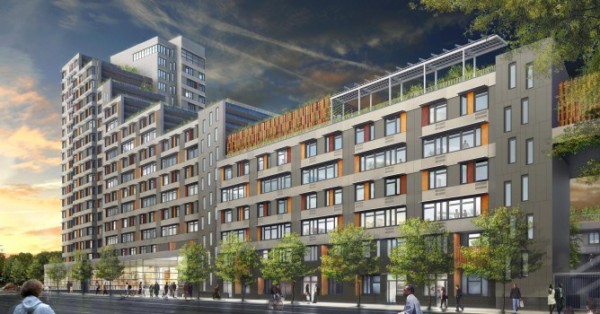The Bronx, known as the birthplace of hip-hop and the home of the Yankees, will soon lay claim to a new, and unexpected, title: the home of solar innovation.
Via Verde, “The Green Way,” an 18-story, mixed-income development currently under construction on East 156th Street, will be outfitted with almost 300 solar panels that will produce 15-20 percent of the energy needed to run the building’s elevators, water pumps, and air conditioning in common areas. The design is innovative for several reasons: it uses off-the-shelf components to keep cost down and places solar panels on multiple different vertical surfaces. By using the vertical spaces for solar, the architects have freed up the rooftops for gardens.

The photovoltaic solar panels will be mounted on the $100 million building’s exterior wall on six vertical faces, which step up from south to north. Two horizontal arrays will be mounted on trellises above the fifth and seventh floor roofs to provide shading for gardens and two more will be on the tower roof. The system has a capacity of 66 kilowatts — power that can flow into the grid when the the building doesn’t need it.
 Solar panels sit on the vertical steps of Via Verde. Rendering/courtesy Phipps Rose Dattner Grimshaw
Solar panels sit on the vertical steps of Via Verde. Rendering/courtesy Phipps Rose Dattner Grimshaw
“The traditional [layout] is the big, flat, industrial roof where you can just lay out row after row of panels in a cookie cutter way,” said Andrew McNamara, vice president of new construction at Bright Power, which provided energy consulting for the project. “This is totally unconventional.”
The design of the building called for the rooftop surfaces to be used for green space, so project architect Robert Garneau, of Grimshaw Architects, worked with McNamara and Dattner Architects to maximize the efficiency of the panels while preserving the architectural vision of the project. The panels are tilted out slightly from the vertical so they still produce at high efficiency. The system provides 2.5 percent of the building’s overall power usage — including the residential units — and helped the structure qualify for the Leadership in Environmental and Energy Design (LEED) Gold certification.
Garneau said designing for solar requires forethought about the orientation of the building, shading from nearby structures, and the right building materials. But once the panels are installed, he added, “You just forget about them and they keep producing power.” The panels produce the most energy in the summer, when electricity needs are greatest for air conditioning systems.
 Looking down on the stepped, green roofs of Via Verde. Rendering/courtesy Phipps Rose Dattner Grimshaw
Looking down on the stepped, green roofs of Via Verde. Rendering/courtesy Phipps Rose Dattner Grimshaw
The project, which includes 151 low-income rental units and 71 middle-income co-op units, benefits from renewable energy incentives and rebates from several levels of government. The payback period for the solar installation is approximately 15 years. But the structure will also serve as a showpiece for the next generation of green, affordable housing.
“I think you’ll start seeing more and more PV panels on projects throughout NYC,” said Ari Goldstein of co-developer Jonathan Rose Companies, which is working with Phipps Houses.
 Construction on Via Verde is slated for completion in early 2012. Photo/courtesy Grimshaw Architects
Construction on Via Verde is slated for completion in early 2012. Photo/courtesy Grimshaw Architects
![]() Editor’s Note: This cross posted content is provided to us via Txchnologist and its editor Matthew Van Dusen.
Editor’s Note: This cross posted content is provided to us via Txchnologist and its editor Matthew Van Dusen.